Cheap Beer's Burp in the Road
The newsroom
refrigerator was nearly packed full. Junior reporter Junko sat at the
office kitc hen table eating her lunch. I continued working.
"Big night tonight," I said. I unloaded the
last 6-pack of Kirin's new Gokunama brand happoshu from the
cart and held it in my right hand.
"How so?" She looked up.
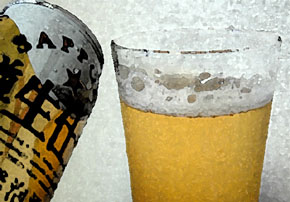 "In order to keep up with
Japan's latest beverage market trends, I like to do an in-depth study
immediately after a new brand of happoshu is introduced." I
placed the pack of Kirin's latest alternative to beer into the
refrigerator.
"In order to keep up with
Japan's latest beverage market trends, I like to do an in-depth study
immediately after a new brand of happoshu is introduced." I
placed the pack of Kirin's latest alternative to beer into the
refrigerator.
"Yeah, but that stuff is going to be taxed like
regular beer soon enough."
"As I'm sure you heard the happoshu tax increase
proposal was overturned once again late last year. This is two years
in a row that we drinkers have been victorious over greedy government
officials' attempts to raise the price. It's getting to be like
child's play."
"The idea is a waste anyway. Even though
alcoholics like you will pay a premium to drink raw sewage if there
is a guarantee of at least 5 percent alcohol content, most other
people will cut back on drinking happoshu because it tastes terrible.
And what about next year? The increase will surely be attempted
again."
"My dear, for someone like me, a person who looks
ahead hours when making decisions, this one year might as well be a
lifetime."
I closed the refrigerator
door and smiled. Junko returned to her eating.
At Liquors Hasegawa's North Exit branch in the
Yaesu Shopping Mall underneath
Tokyo Station, manager Shunji Hasegawa has seen a lot in his 30
years of selling beer, wine, and whiskey to thirsty Japanese drinkers
on the move through the busy station. He's weathered the oil shocks
of the '70s, temporary economic downturns, and the ever-changing
whims of the Japanese consumer.
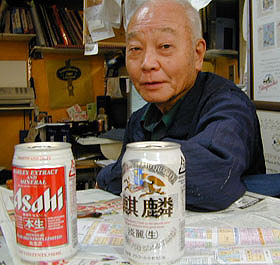 But if certain bureaucrats get their way
he's going to face perhaps his greatest challenge yet: an increase in
the tax levied on a very popular alcohol innovation - happoshu.
"If it happens, business will be very tough," he
grimaces.
But if certain bureaucrats get their way
he's going to face perhaps his greatest challenge yet: an increase in
the tax levied on a very popular alcohol innovation - happoshu.
"If it happens, business will be very tough," he
grimaces.
Happoshu, or literally "sparkling liquor," is
a beer-like low-malt alcoholic beverage that is extremely popular
with consumers because of its very low price relative to regular
beer. The price difference is due to a tax categorization
loophole.
After noticing its great popularity, government
officials are keen to fix it so that happoshu is priced closer to
that of regular beer and scoop off, what they hope to be, that extra
froth. The mild taste of this tipple is another matter entirely,
though, and beer aficionados wonder if a price boost wouldn't simply
cause happoshu to lose all of its fizz altogether.
Currently, an average 350-milliliter can of happoshu
has a suggested retail price of 145 yen, roughly 75 yen less than
that of regular beer. The all-important alcohol content is typically
the same as that of regular beer.
The majority of the price difference is in the alcohol
tax. The Liquor Tax Law of Japan defines beer to be an alcoholic
beverage with 66.7 percent malt content. Happoshu contains less than
25 percent malt, a percentage that gives it an alcohol tax that is
less than half the amount imposed on beer.
Along with prices for fast food, clothing and real
estate, to name but a few, the low price offered for these alcoholic
beverages is yet another symptom of the deflationary economy that
exists in Japan today.
Things were different in the 1980s. This was a time of
high economic growth. In those days, family incomes were growing and
brand loyalty reigned. Manufacturers reaped large profits as
consumers snapped up goods at nearly any price.
Today, times have changed; household budgets are being
cut; consumers are looking for bargains; and retailers must
cut manufacturing and distribution costs to oblige.
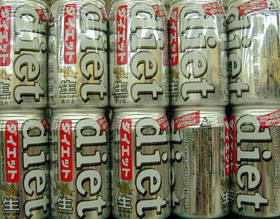 Suntory first introduced
happoshu to Japan in October 1994. Since then each of Japan's four
top breweries have developed their own brands.
Suntory first introduced
happoshu to Japan in October 1994. Since then each of Japan's four
top breweries have developed their own brands.
Today's market is awash in a great variety of
concoctions whose attraction to the consumer is generally through
some kind of visual stimulation conceived by the maker rather than an
emphasis on the taste of the product.
Sapporo's "Brau" features lettering and
artwork that alludes to brews from Germany, the location of the
brewing techniques adopted by most major Japanese brewers.
But perhaps the most talked about happoshu brand has
been Suntory's "diet," promoted on television commercials
by Prime Minister Koizumi's son, Kotaro. In the ads, he holds a can
up to the camera, enjoys a few gulps, and smiles. He explains that
the drink is delicious and then continues to explain that by simply
enjoying this cold brew one can become slimmer.
There has been nothing slim about happoshu's results,
however. Since its inception, shipments have posted year-on-year
gains and today account for over 30% of all beer sales in Japan - the
world's fifth largest beer market.
Rather ironically, it is the ongoing plans of the elder
Koizumi
and his bureaucratic friends that might eventually put a crimp in his
son's business.
With business booming at such a nice clip, the Liberal
Democratic Party's Tax Research Council last year decided that it
wanted to increase the tax of happoshu to nearly that of regular
beer. The Ministry of Finance proposed that the increases be done
gradually in increments of 20 yen. A similar measure was tried by
bureaucrats the year before but it was shot down. Last year's attempt
fared no better; it was defeated in December.
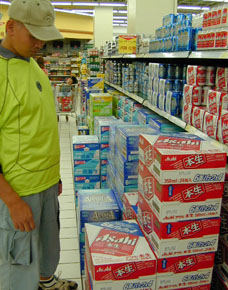 The proposed increase was to make up for a
shortfall in tax revenue and fund economic stimulus measures for
small and medium-sized businesses. Preliminary estimates by the
Council have revealed that upwards of 250 billion yen could be
generated annually from such a move.
The proposed increase was to make up for a
shortfall in tax revenue and fund economic stimulus measures for
small and medium-sized businesses. Preliminary estimates by the
Council have revealed that upwards of 250 billion yen could be
generated annually from such a move.
Japan's beer makers joined forces to lead the charge
against the measure. A lobby group was formed and a web page launched, complete
with a logo featuring an angry-faced silver can with red bandana and
bubbles fizzing above its top. Visitors to the web page today are
thanked by the can for their support during the most recent fight.
With the ruling Liberal Democratic Party's popularity,
and strength, having declined due to a series of scandals over the
past year, its chances of pushing the measure through anytime in the
immediate future appears small. The added threat of a consumer
backlash, a possibility given the nature of Japan's economy, further
lessens the likelihood.
Given this, it is still anticipated that a similar tax
increase plan will eventually be tried by bureaucrats once again when
political and economic conditions are more favorable.
But the measure's latest defeat aside, wouldn't a price
increase cause happoshu to lose its one great selling point - low
price, and cause that anticipated tax revenue to disappear?
"It tastes like medicine," says Ayumi Wada of
Asahi's Hon-nama brand. The 28-year old masseuse and drinker of Ebisu
beer does admit to occasionally drinking Kirin's Tanrei because of
the price and the fact that among happoshu choices its taste "is
the best of the worst."
From behind the counter at his shop, Hasegawa gives an
equally negative assessment of the taste of all the brands. But to
him, they generally all taste the same. He emphasizes that since the
alcohol content is roughly the same as regular beer, the
bang-for-your-yen principle is the most important aspect to sales,
especially in this economy.
Out of Japan's 10-year economic downturn, cheap alcohol
has been one of the few positives. Most would like it to stay that
way, taste be damned.
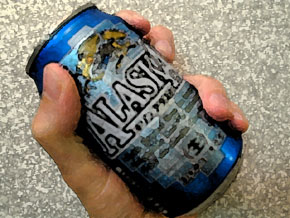 Wada adds, "Generally, it
is too light. It doesn't taste good. If the tax were raised, I would
never drink happoshu. I would just drink Ebisu."
Wada adds, "Generally, it
is too light. It doesn't taste good. If the tax were raised, I would
never drink happoshu. I would just drink Ebisu."
She is not alone.
Hideki Kimura, a 32-year old maintenance worker, making
a whiskey purchase at the counter of Liquors Hasegawa, shrugs his
shoulders and says, "I'd just always buy Sapporo beer if the tax
were raised."
"If the tax goes up," Hasegawa explains while
ringing up Kimura's sale, "of course people will stop buying it.
Basically, the government is stupid."
There is a very good reason why happoshu's taste is
lousy; it is made with cheap ingredients. Malted barley will generally
give a real beer its flavor. In happoshu, less expensive starches and
sugars replace malted barley in the brewing process.
"People who know beer will say this isn't
beer," says Hidekazu Yoshihira, a professional brewer of seven
years with an operation located in a suburb just outside of Tokyo.
Yoshihira, who almost never drinks happoshu himself
unless it is the only drink available when he is out of his house,
adds, "It is best to classify it as something other than
beer."
He sees the industry headed towards further developing
products that all taste the same, with any depth, character, and
differences between the brands being completely lost.
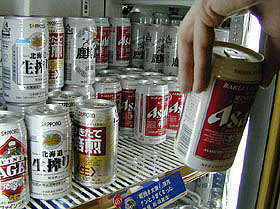 "The companies are making the taste
milder to encourage the consumer to drink more," he says.
"The companies are making the taste
milder to encourage the consumer to drink more," he says.
The initial success of happoshu has bred some hefty
competition. With taste not being a key to sales, there is no brand
loyalty among consumers. Price is all that matters. Thus, a
full-blown happoshu price war has been raging over the last year
among the major brewers.
It began on March 1st when Kirin introduced its
Goku-nama brand at a price that was 10 yen less than the
competition's price of 145 yen. Kirin was able to do this by cutting
production costs, sales rebates, and television advertising. The cans
are gunmetal gray with only blue lettering to simplify manufacturing
processes. Only blue is used for the lettering on the shipping boxes
as well.
Asahi and Suntory responded quickly by matching Kirin's
price, but only for a short time. After that price drop, Asahi's
Hon-nama quickly became the biggest selling happoshu at Hasegawa's
shop.
Asahi was the last major brewer to develop a happoshu
brew. Kirin and Asahi have been battling for market share for some
years now. It wasn't until just a few years ago that Asahi finally
surpassed Kirin as Japan's number one brewer with its "Super
Dry" regular beer brand. At the time, Kirin was focusing on
developing a line of happoshu products.
The strategy worked for Kirin. Today, Kirin commands a
happoshu market share of nearly 40 percent, the most of any brewer.
Sensing success on the part of Kirin and the other brewers with
happoshu, Asahi finally relented and Hon-nama was the result.
How low can the price go? Thus far, nobody knows. But
prices have been falling so quickly that happoshu has been turning up
in discount
liquor shops for less than 100 yen a can.
Even if the tax is increased one day, is it be possible
that some people might actually continue to buy happoshu because they
have become accustomed to the taste? It is a possibility. Happoshu
does indeed have supporters, though admittedly very few.
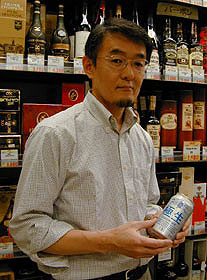 Kenji Araki manager of Liquors
Hasegawa's main store in the same mall sums up his opinion of
happoshu as: "Yes, it is like water. But it is light and good in
a refreshing way. Some people like it for this."
Kenji Araki manager of Liquors
Hasegawa's main store in the same mall sums up his opinion of
happoshu as: "Yes, it is like water. But it is light and good in
a refreshing way. Some people like it for this."
The 45-year old Araki argues that some people who might
previously have shunned happoshu because of its low, working
class-type association could perhaps turn to it as a trendy
alternative to beer.
This is not as strange as it might sound. In 1994,
brewing regulations in Japan were lessened. The minimum annual volume
of output required for a brewing license for beer was lowered from
2,000 kiloliters to 60 kiloliters. For happoshu, the requirement was
set at a paltry 6 kiloliters.
This easing has made it easier for smaller operations
to start churning out smaller, hand-crafted products. Some of them
have even been happoshu with ingredients that have included
vegetables and fruit.
In Kawagoe, Saitama Prefecture, Koedo Brewery uses
local potatoes for its mild "Sweet Potato Lager." Topping
them in uniqueness in ingredients is "Iyo Tangerine
Happoshu," crafted by a small brewery in Kawanoe, Ehime
Prefecture with the juice of tangerines found in the prefecture.
Araki believes that happoshu does indeed have a
legitimate niche in the beer market. "Even if the tax were
increased, some people would buy it," he says. "Certainly
it would not be as popular as it is today, but it would not go away
either."
Note: Edward Gelband contributed to this report from
the Tokyo Bureau.

